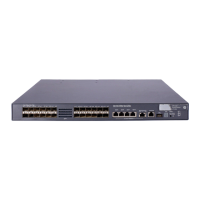177
To do… Use the command Remarks
4. Configure the reflector port
for the remote source
mirroring group.
mirroring-group group-id reflector-port
reflector-port
Required.
By default, no reflector port is
configured for a mirroring
group.
5. Create the remote probe
VLAN and enter VLAN view.
vlan vlan-id
Required.
By default, no remote probe
VLAN is configured for a
mirroring group.
6. Assign monitor ports to
the remote probe VLAN.
port interface-list
Required.
By default, a newly-created
VLAN does not have any
member port.
7. Return to system view.
quit —
8. Configure the remote
probe VLAN for the
remote source mirroring
group.
mirroring-group group-id remote-probe vlan
rprobe-vlan-id
Required.
By default, no remote probe
VLAN is configured for a
mirroring group.
NOTE:
• The reflector port of a remote source mirroring group must be an access port and belong to the
default VLAN, VLAN 1.
• HP recommends you configure an unused port as the reflector port of a remote source mirroring
group and disable STP on it.
• A mirroring group can contain multiple mirroring ports.
• To make sure that the port mirroring function works properly, do not assign a mirroring port to the
remote probe VLAN.
• If you have already configured a reflector port for a remote source mirroring group, you can no
longer configure an egress port for it.
• A VLAN can only serve as the remote probe VLAN for one remote source mirroring group. HP
recommends you use the remote probe VLAN for port mirroring exclusively.
• A remote probe VLAN must be a static VLAN.
• To remove the VLAN configured as a remote probe VLAN, you must remove the remote probe VLAN
with undo mirroring-group remote-probe vlan command first.
• If the remote probe VLAN of a remote mirroring group is removed, the remote mirroring group will
become invalid.
• The link type of monitor ports configured for port mirroring must be access.

